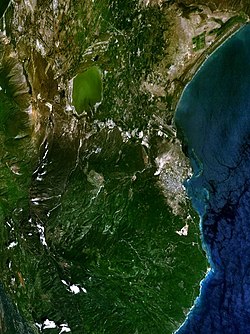Barahona, Dominican Republic
Barahona, also known as Santa Cruz de Barahona, is the head municipality of the Barahona province, on the southwest of the country.
Barahona | |
|---|---|
| Santa Cruz de Barahona | |
 Google Earth image of Barahona. | |
| Coordinates: 18°12′N 71°06′W / 18.200°N 71.100°W | |
| Country | |
| Province | Barahona |
| Founded/Founder. =Toussaint L'ouverture | 1802 |
| Municipality since | 1858 |
| Area | |
| • Total | 163.02 km2 (62.94 sq mi) |
| Elevation | 10 m (30 ft) |
| Population (2012)[3] | |
| • Total | 138,159 |
| • Density | 850/km2 (2,200/sq mi) |
| • Demonym | Barahonero(a) |
| Municipal Districts | 3 |
| Climate | Aw |
It is the largest city of the Dominican southwest and the centre of the region.
Population
The municipality had, in 2010, a total population of 62,054: 30,799 men and 31,255 women. The urban population was 98.9% of the total population, one of the most urban municipality in the country.[3]
History
Since the 18th century, the region was occupied by fishermen and people that came here to cut trees. When Toussaint L'Ouverture took the eastern part of the Hispaniola island in the name of France, he gave the order to create the town of Barahona in 1802 as part of the Ozama Department.[4]
After the Independence in 1844, Barahona was a military post of the Azua Province.
In 1858, Barahona was elevated to the category of municipality. When the province was created in 1881, Barahona was made its head municipality.
Geography
The city of Santa Cruz de Barahona is in a plain along the coast, in the lower valley of the Yaque del Sur river. Part of the municipality is on the mountains of Sierra de Bahoruco.
Barahona is at 200 km (124 mi) to the west of Santo Domingo. The limits of the municipality are the municipality of Fundación to the north, the Caribbean Sea to the east, the municipality of La Ciénaga to the south and the municipality of Cabral to the west.
Climate
Barahona has a tropical wet and dry/savanna climate (Köppen climate classification : Aw).[5] The climate on the mountains of the Sierra de Baoruco, where there are some rainforests, is cooler and more wet.
The average amount of rainfall for the year in the city is 1,019 mm (40.1 in). Most rains fall during the end of summer. The month with the most precipitation on average is October with 185 mm (7.3 in) of rainfall, followed by May with 169 mm (6.7 in).
The driest season is winter. The month with the least rainfall on average is February with an average of 29 mm (1.1 in) and the second is January with 30 mm (1.2 in).
Barahona is in a warm region; the average temperature for the year is 26 °C (79 °F). The warmest months, on average, are July and August with an average temperature of 28 °C (82.4 °F). The coolest months on average are December, January and February, with an average temperature of 25 °C (77.0 °F).
| Climate data for Barahona (1961–1990) | |||||||||||||
|---|---|---|---|---|---|---|---|---|---|---|---|---|---|
| Month | Jan | Feb | Mar | Apr | May | Jun | Jul | Aug | Sep | Oct | Nov | Dec | Year |
| Average high °C (°F) | 29.3 (84.7) | 29.2 (84.6) | 29.5 (85.1) | 30 (86) | 30.3 (86.5) | 30.7 (87.3) | 31.7 (89.1) | 31.9 (89.4) | 31.5 (88.7) | 30.7 (87.3) | 30.6 (87.1) | 29.8 (85.6) | 30.4 (86.8) |
| Daily mean °C (°F) | 24.8 (76.6) | 25 (77) | 25.6 (78.1) | 26.3 (79.3) | 26.8 (80.2) | 27.4 (81.3) | 28 (82) | 27.9 (82.2) | 27.4 (81.3) | 26.6 (79.9) | 26.2 (79.2) | 25.3 (77.5) | 26.4 (79.6) |
| Average low °C (°F) | 20.3 (68.5) | 20.7 (69.3) | 21.6 (70.9) | 22.6 (72.7) | 23.3 (73.9) | 24.1 (75.4) | 24.3 (75.7) | 24 (75) | 23.3 (73.9) | 22.6 (72.7) | 21.8 (71.2) | 20.7 (69.3) | 22.4 (72.4) |
| Average rainfall mm (inches) | 30.4 (1.20) | 29.3 (1.15) | 45.1 (1.78) | 64.1 (2.52) | 168.5 (6.63) | 129.5 (5.10) | 38.1 (1.50) | 65.1 (2.56) | 143.7 (5.66) | 184.9 (7.28) | 75.6 (2.98) | 44.4 (1.75) | 1,018.7 (40.11) |
| Source 1: NOAA[6] | |||||||||||||
| Source 2: Climatemps.com[5] | |||||||||||||
Administrative division
The municipality of Santa Cruz de Barahona has three municipal districts;[3] these are:
| Code | Municipal district | Population (2010) |
|---|---|---|
| 040102 | El Cachón | 2,046 |
| 040103 | La Guázara | 1,892 |
| 040104 | Villa Central | 17,627 |
Economy
The main economic activity of the province is agriculture; the main product in the municipality is a very good coffee ("Barahona Type Coffee"), grown in the mountains of Eastern Bahoruco.
There are also some important industries, mainly to produce textiles to send to other countries, and sugar in the Ingenio Barahona ("Barahona Sugar Factory").
There is a port in the city; it is used to send coffee and sugar to other countries.
References
| Provincial capitals of the Dominican Republic |  |
|---|---|
| Azua • Baní • Barahona • Bonao • Comendador • Cotuí • Dajabón • El Seibo • Hato Mayor • Higüey • Jimaní • La Romana • La Vega • Mao • Moca • Monte Cristi • Monte Plata • Nagua • Neiba • Pedernales • Puerto Plata • Sabaneta • Salcedo • Samaná • San Cristóbal • San Francisco de Macorís • San José de Ocoa • San Juan de la Maguana • San Pedro de Macorís • Santiago de los Caballeros • Santo Domingo • Santo Domingo Este | |

